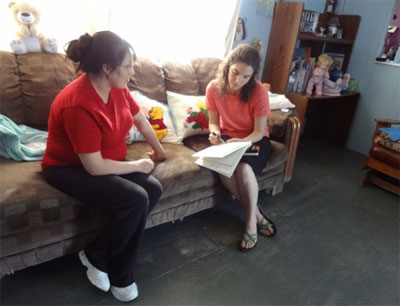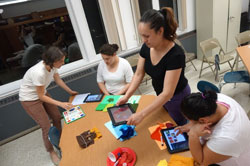The Harvard Family Research Project separated from the Harvard Graduate School of Education to become the Global Family Research Project as of January 1, 2017. It is no longer affiliated with Harvard University.
|
March 19, 2015 Q & A With Comienza en Casa: Using Technology to Smooth the Transition to School for Migrant Children and FamiliesHarvard Family Research Project
|
FINE Newsletter, Volume VII, Issue 1
Issue Topic: Engaging Families, Schools, and Communities in the Transition to School
Voices From the Field
Comienza en Casa | It Starts at Home is a project of the nonprofit group Mano en Mano | Hand in Hand. Comienza en Casa works with migrant families so they can support their young children during the transition to school. The program provides parents with early learning activities they can do at home with real-world materials or on an iPad supplied by the program. Monthly meetings at the elementary school and home visits are also part of the offerings. Ana Blagojevic, program coordinator, and Bonnie Blagojevic, program consultant, shared their experiences with HFRP.
|
COMIENZA EN CASA AT A GLANCE Community served: Milbridge, Maine (Small coastal town with a population of approximately 1,300 people) |
|
Comienza en Casa supports children and families across the transition to school, in part, by providing families with iPads to use in the home. Why did you choose to include technology in this family engagement program? |
|||||||
|
We started Comienza en Casa in the fall of 2012 to provide migrant Latino families, who had recently settled in the community, with information and tools to support their young children’s learning. We knew that many children in our community were not entering kindergarten with the skills they needed. We wanted to provide opportunities for parents to support their children’s learning at home in their home language.
|
|||||||
|
Can you give an example of what a digital experience for a parent and child might look like? |
|||||||
|
Sure. Each month, at the group meeting, we provide parents with information about early learning. We also give families an activity sheet that identifies a focus topic, such as physical science, four or five early-learning goals and related activities, some using an iPad and some off-screen. These are the activities that parents do with their children at home. The iPad activities include opportunities to read or hear e-books, play educational games, and create stories or digital projects. Through a collaboration with Ready Rosie, we are also able to provide families with videos in Spanish that give examples of games and activities they can try at home. |
|||||||
|
What does a typical home visit look like? |
|||||||
|
Families are using technology to document, create, and explore projects with their children that we had never imagined! We spend a great deal of the time during home visits reviewing their work together. For example, one young boy and his mother, using the camera on an iPad, wrote a short digital story about the process of planting peas.
On home visits, we also typically have a template where we will review the learning goals and unit material with the parents and talk about which activities they are planning to do. Sometimes we brainstorm how they might be able to do all of those activities around their busy schedules. The home visit is also a great way for us to get information to improve our programming. We always ask parents for their feedback and to rate each app that we have suggested so that we can improve our work. We use checklists that we have developed to do this. |
|||||||
|
To what extent do you collaborate with the local elementary school? |
|||||||
|
We hold our monthly evening meetings at the Milbridge Elementary School. We are lucky to have the kindergarten teacher at Milbridge Elementary, Suzen Polk-Hoffses, join us. At the beginning of the meeting, Suzen leads a bilingual story reading, and families and children together share favorite books, stories, or projects they created. Sometimes a special guest, like a lobsterman, might speak. In the second part of the session, children go to the kindergarten room with a Mano en Mano staff member to play and explore materials, while Ana and Suzen facilitate a meeting with parents. Meetings center on early learning goals for the upcoming month and how activities connect to what the children will learn in kindergarten.
Just as Comienza en Casa has positively affected children and families, it has also had a positive influence on what happens in kindergarten classrooms. As one example, after a kindergarten class trip to a blueberry farm, one child from Comienza en Casa came home and told his mother, “I need to make a book about blueberries!” He made drawings about how blueberries grow, photographed them using the camera on his iPad, and added his voice using a digital storytelling app. When Suzen saw his digital story, she started providing opportunities for children in her class to create similar projects. "How Berries Grow" a digital story written by a family in Comienza en Casa |
|||||||
|
Technology can positively impact what teaching and learning in classrooms can look like. You can check out the iTunes U course Wild Blueberry Farming in Maine which details the study done in Suzen’s classroom. |
|||||||
|
Comienza en Casa also has a relationship with the local library. Can you tell us more about how this partnership supports the transition to school? |
|||||||
|
Many families were not familiar with the local library and what it has to offer. For this reason we integrated library orientations into our program, and Mano en Mano donated its collection of Spanish and bilingual picture books to the library. With the help of an AmeriCorps volunteer, we also offered several bilingual story hours, which many families in our programs attended. Parents shared with us that there were very few resources for adults in Spanish at the Milbridge Public Library. They also had the idea for a Children’s Day Celebration fundraising event at the library. As part of the event, with the help of a high school student, community members completed surveys indicating what type of Spanish-language magazines they would like to see in the library and what kind of authors they would like to read. The money raised through that event went to purchasing a bunch of books and magazine subscriptions for the library. As a result of these activities, the library is a much more welcoming place for families to come and spend their time and help support their children’s learning. |
|||||||
THE DIGITAL CONNECTION
Comienza en Casa uses different digital creativity and literacy tools in its work. Check out a few:
Ready Rosie is an online family engagement tool that offers short videos of real families doing learning activities in the home and community with their young children. Check out a few videos including: Monkey Around, All Done, Following Directions and Búsceda de Zapatos.
Book Creator is a simple way to create iBooks, right on the iPad. It allows users to include text, pictures and audio with your book and share your creation with others.
Shadow Puppet is a creativity app that allows you to create videos to tell a story, explain an idea or send a personalized message.
About Bonnie Blagojevic and Ana Blagojevic:
 Bonnie Blagojevic
|
Bonnie Blagojevic is an education consultant, Apple Distinguished Educator and adjunct faculty member at The University of Maine. She is a consulting editor for NAEYC, has co-authored technology related articles for NAEYC’s Teaching Young Children magazine as well as other NAEYC publications, and is an active member of the NAEYC Technology & Young Children Interest Forum. Bonnie has more than 30 years experience as an early education professional working in a variety of settings, including a high school lab preschool, a university preschool program, a family child care home, and a nonprofit center. |
 Ana Blagojevic
|
Ana Blagojevic is the Migrant Programs Coordinator at Mano en Mano | Hand in Hand. For the past four years she has provided advocacy services for migrant youth ages 3-21 and their families. In 2012, Ana started working with Comienza en Casa | It Starts at Home. Before her work at Mano en Mano, Ana served as Director at the Red Hook ESL Center during her time as a Bard Trustee-Leader Scholar. |
This Q & A was condensed and edited by Jamarcus Purley. Jamarcus Purley is a research assistant at Harvard Family Research Project who works on research related to anywhere, anytime learning and projects for the Family Involvement Network of Educators. Jamarcus graduated with a degree in English and Education from Stanford University in 2013.
This resource is part of the March FINE Newsletter. The FINE Newsletter shares the newest and best family engagement research and resources from Harvard Family Research Project and other field leaders. To access the archives of past issues, please visit www.hfrp.org/FINENewsletter.




